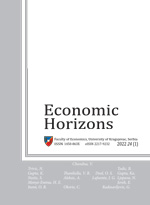POST-CRISIS REALLOCATION OF GROWTH FACTORS
Edvard Jakopin
Ministry of Finance – Department of National Development, Belgrade, Serbia
The global recession has once again confirmed the economic principle stating that economic growth is not attainable unless there are continuous structural changes. The transition models of the reallocation of growth factors have demonstrated how inefficient they were when the recession struck. A research into the transitional growth of productivity has shown that productivity has primarily been based on an "intrasectoral profit", not on the so-called "reallocation effect". The entire area of SEE is faced with systemic macroeconomic imbalances primarily of a structural character. On the other hand, a comparative analysis of the reform experiences shows that transitional scores depend both on the speed of the undertaken reforms and the starting position. Studies have clearly demonstrated that sustainable economic growth was higher in those transition economies in which reforms were pursued faster than in those that pursued the strategy of incremental development. The crisis brought to the fore the signifi cance of industrial policies that had been sidelined both in theoretical and practical terms. The focus of the post-crisis reallocation of growth factors in the new model of economic growth should be on structural changes steered towards the productive export sectors of the manufacturing industry.
Keywords: reallocation of growth factors, macroeconomic imbalances, development gap, post-crisis structural transformations
JEL Classification: O11, O47, L16, P21, O25, H62, J24
Economic Horizons, 2012, Vol. 14, No. 2, pp. 79-90. doi:10.5937/ekonhor1202077J
| Full Text |




